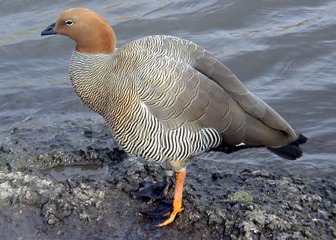Ruddy-headed Goose
It breeds on open grassy plains in Tierra del Fuego, Chile and the Falkland Islands. The South American birds are now very rare. They winter on lowlands in southern Argentina, some distance north of the breeding range. The Falklands population is resident.

The Ruddy-headed Goose is classified as Least Concern. Does not qualify for a more at risk category. Widespread and abundant taxa are included in this category.
The Ruddy-headed Goose (Chloephaga rubidiceps) is a large sheldgoose, which breeds in southernmost South America. It breeds on open grassy plains in Tierra del Fuego, Chile and the Falkland Islands. The South American birds are now very rare. They winter on lowlands in southern Argentina, some distance north of the breeding range. The Falklands population is resident. The lined nest is built amongst grass tussocks, and 4-11 eggs are laid. More
The ruddy-headed goose is classified as Least Concern (LC) on the IUCN Red List 2007 (1) and is listed on Appendices I and II of the Convention on Migratory Species (CMS or Bonn Convention) (3). Description - The ruddy-headed goose has boldly patterned plumage, with fine brown and blackish barring on the shoulders and breast, becoming more distinct on the flanks. More
R Moller Jensen Ruddy-headed Goose: less than 1,000 remain in mainland South America. Zoom In A first for the Americas... = 31-08-2007 The first ever Convention on Migratory Species (CMS) agreement for an American migratory bird species has been announced. The new agreement calls for both Argentina and Chile to coordinate conservation measures that will halt recent declines in the mainland South American population of Ruddy-headed Goose Chloephaga rubidiceps. More
Ruddy-headed Goose signed by Argentina and Chile in November 2006. The CMS Secretariat is the Depositary of the agreement, which was drawn up under Article IV of the Convention. Two populations of the Ruddy-headed Goose (Choephaga rubidiceps), which is the smallest austral goose inhabiting South America, have been identified. More
the Conservation of the Ruddy-headed Goose (Chloephaga rubidiceps) was concluded under CMS auspices and became effective on 21November 2006. It aims to safeguard the mainland population of this species, which is in serious danger of extinction with an estimated size at around 900-1,000 individuals. Due to its critical status, this population is listed in the CMS Convention’s Appendices I and II. Currently its effective conservation depends on concerted actions between the two signatory states. More
inspection shows that the Ruddy-headed Goose is smaller with less pronounced barring to the abdomen. The Ruddy-headed Goose is also more dependent on established ponds for breeding. Nests are built of grass and lined with breast feathers, with 5 to 8 eggs being laid in October. Young leave the nest shortly after hatching, and feed themselves on invertebrates and vegetation under the supervision of the parents. Chicks fledge in January or February. Sexes are similar in appearance. More
The Ruddy-headed Goose Chloephaga rubidiceps is also very special. This species was once numerous in Tierra del Fuego, but has been driven to the brink of extinction there by man, decimated by the introduction of the Patagonian grey fox and shooting in its winter quarters. The Falklands now hold most of the world population of this attractive little goose, which is classified as Near Threatened by BirdLife International. It is fairly common in the Islands, though less numerous than the Upland Goose. More
The Ruddy-headed Goose (Chloephaga rubidiceps) is a fairly rare goose of the Patagonian steppe of southern Argentina and Chile. It also occus onthe Falkland Islands. It is somewhat similar in appearance to a female Upland Goose (C. picta) which is far more common. The bird here was photographed on New Island, Falkland Islands, in January, 2004, with a Canon EOS 10D and EF 70-200 F/2.8 L IS lens and 1.4X extender. More
ruddy-headed goose's population wintering in southern Buenos Aires province. The specific objectives were to better delimit its wintering area, to look for sites with large numbers, to study its habitat used, and to identify main threats to the species. Two intensive surveys were conducted during the austral winter of 1999. More
Family : Anatidae
Genus : Chloephaga
Species : rubidiceps
Authority : P.L. Sclater, 1861
